Dushyasana laughed at Yudhishtira for being a poor looser at the gambling table. Draupathi was dragged in from the middle of people behind whom she was hiding. She pleaded for mercy and begged hapless Yudhishtira for help. Her lips quivered, and her face shrunk. And years later, she pleaded Krishna not to help Pandavas reconcile, but to get them to war. Krishna remained calm and pleasant all through, his green face betraying no emotions. And in the ultimate war, Bheema was unstoppable. His face burned, eyes went red and his body trembled with anger as he searched for Dushyasala. And when Dushyasana fell, a raging Bheema drank his blood and pulled out the intestine with his canines.
Scenes from a Kathakali performance!
I was at a Kathakali performance organized by Bangalore Club of Kathakali and the Arts last weekend. Having got consent to shoot backstage, we arrived early and spent time watching the faces slowly come alive with colors. Here are some pictures and a few words. See more images on flickr group India Travel and Photography.
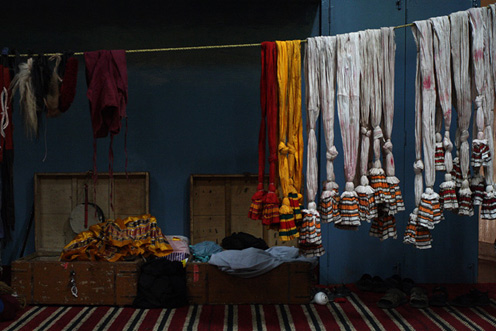
At the backstage
Preparing for the performance is a long process. The artists start applying colors on their face first, and then take help of a make-up person to give the final touches. Mixing colors started as early as 12pm for the show that was about to begin at 6.30pm. When we arrived at the scene around 2 o’clock, the greenroom was full with artists at various stages of colouring their face.

The artists relax before getting ready for the show
The day’s story was Duryodhana Vadham consisting four scenes. The first one is from the court of Dhritarashtra where Yudhisthira gambled away his clan and kingdom. The remaining scenes involved Krishna’s reconciliation efforts after the Pandavas return from exile, the war at Kurukshetra and Bheema’s revenge against Dushyasana and Duryodhana.
Our first introduction to the characters happened as the artists painted their faces with a brush in one hand and mirror in the other. Dushyasana – the evil – was painted in red(katti), while the good guys Yudhishtira and Krishna had fluorescent green (paccha) faces. Duryodhana, evil but royal, had a mix of both. Draupathi’s makeup had a fair face with long eyelashes, called Minukku.
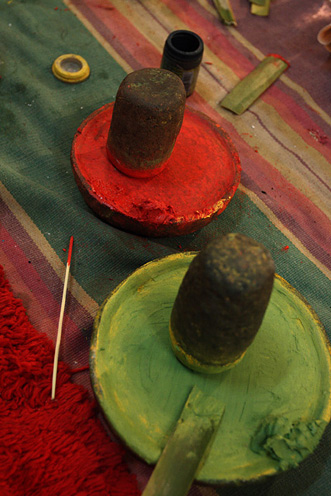
mixing the colors
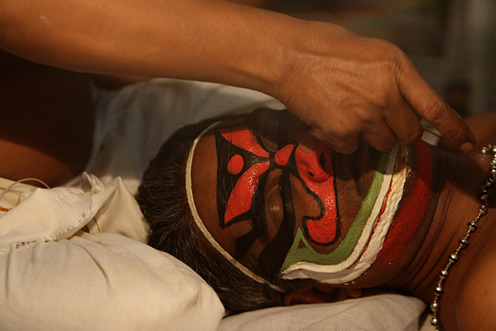
Duryodhana is a mix of katti and paccha
Kathakali evolved as an art form nearly four hundred years ago. It was then called Ramanattam, as the stories performed in those days were from the Ramayana. Achuthan Kutty, a retired scientist from BARC, now a connoisseur and artist, explained us with a child like enthusiasm on the intricacies of the art, about its history, the mudras and the rules of the performance.
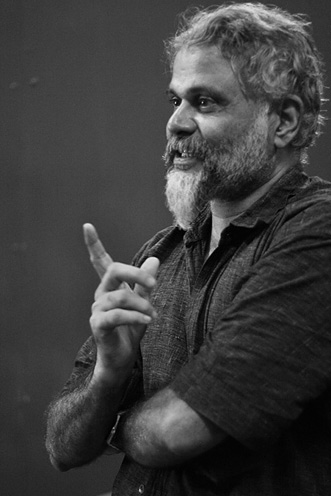
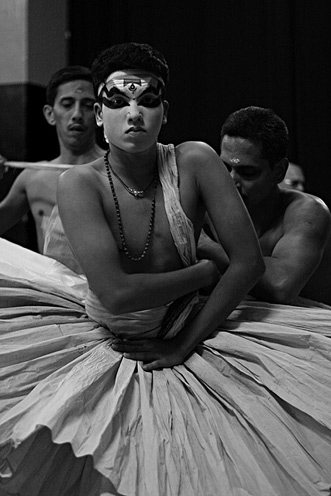
On stage, it was a dazzler of a performance. Two and a half hours went like minutes as the actors duly justified the characters they had become.
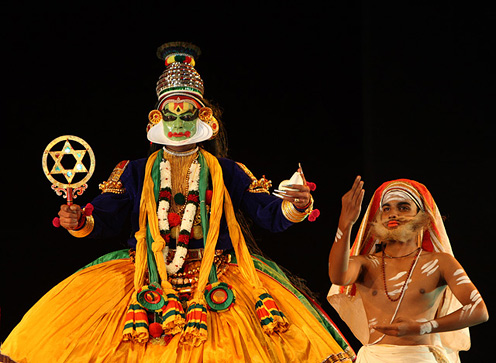
Krishna shows his Vishwaroopa
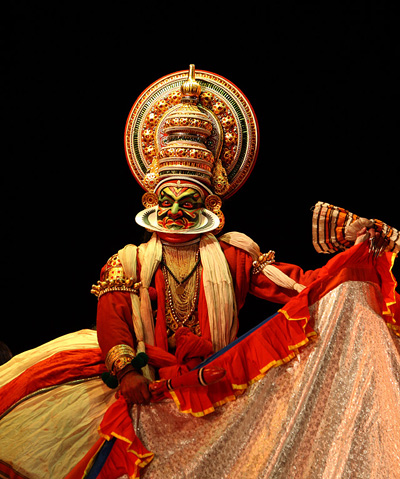
An angry Bheema searches for Dushyasana.
The show culminated with Bheema defeating and killing Dushyasana and Duryodhana in the battle.
See more images on flickr.
To begin with a short introduction, Theyyam is a ritual performed in the temples of north Kerala, in the districts of Kannur and Kasargod. The deity of the temple is believed to occupy the elaborately dressed performer, and speak through him during the performance.

Getting the artist ready for the performance is a long process in itself. People arrive early to see the Theyyam being dressed.

It can take a couple of hours just to get the performer ready.


The last stages of dressing is accompanied with high paced music from the drums. The instrument in the picture is called ‘chanDe’ in Kannada, also used in Yakshagana performances. Anyone knows the Malayalam name?

The complex attire with multiple stages of clothing and ornaments requires help from many assistants.


One of the boys who assists the Theyyam through the performances looks at the artist and smiles after completing the decorations.

In full glory!

Perfecting raudra rasa? The artist looks at himself in the mirror. The kumkum(red powder) added around the lips at the last moment adds to the mood remarkably.

During the performance..
Travelling in Rajasthan in February 2008
Jaipur >> Shekhawati >> Pushkar >> Jaisalmer >> Jodhpur
+ Previous: Jaisalmer
+ Next: Sand dunes of Khuri
Having heard a bit about an unusual guesthouse owned Badal Singh, I was keen to visit him and spend a few days. Badal was known to live with a set of ethics that is much different than what most of Jaisalmer’s tourism industry follows. He would not work with travel agents, doesn’t try to squeeze the visitors of their last rupee, and would not bend the rules to get more business.
Badal lived in a small village called Khuri, an hour’s drive from Jaisalmer. He worked at one of the first ever guesthouses to open in the village, and eventually started on his own by building a few rooms within the compound walls of his house. When he threw open his house to visitors, he did not start off like everyone by enrolling with travel agents or posting signs all over the village. Instead, he simply posted a small sign that read ‘Badal House’, and waited for guests to come. “I did not want to call is a ‘guesthouse’,” he told me during one of our conversations.

Living with his limited means and being content with it, he was not keen to maximize his business potential and make more money. Instead, he focused on making his few guests feel at home, treated them like part of the family, spent time talking to them and telling them of his way of life. He would serve the guests the same food they prepared for the family instead of pampering them with a menu that had no personal touch. He would often tell me – “I get enough money to make a comfortable living, why should I ask for more?”
Good things get eventually discovered. And internet helps accelerate the discovery. Word spread of this unique guesthouse owner whom tourists could trust in, and go back feeling good. Some tourists started coming to Khuri just to stay at ‘Badal House’, and many who had Khuri in their itinerary would simply walk in to Badal House instead of contemplating on their options. He entered into Lonely Planet’s listings a few years back, which nearly ensured continuous flow of visitors. But Badal remained the same person despite all that, renting out his rooms for little money and treating his guests with the same geniality.
His simplicity was evident the very first time I saw him. He is a tall man with gray hair, a big mustache, and an ever present smile on his face. His prominent laugh lines divulged an easy going persona. He spoke with a slow but confident voice and kept his smile as he talked, expressing himself easily, without any inhibitions or apprehensions of speaking to an unfamiliar person.

Badal House is a bunch of rooms randomly constructed inside a small compound. One of the rooms serves as a kitchen, another a store room and another a bed room. A few rooms built along the edge of the compound serve the guests. An open area in the middle works as sit out and dining area, allowing visitors to sit in sun and while away the time.
It was lunch time when I arrived at Badal House, and a few guests had already gathered around a table. I was the only Indian at the house that day. There was an enthusiastic Croat living in Ireland, an Australian who had fallen sick with stomach trouble, and an enthusiastic Polish woman. A French couple had gone to the desert for an overnight camel safari, and were to return that evening. Most of the conversations through the day were naturally centered around travel as people spoke about their experiences of travelling in India and rest of the world.
While I was done listening to travel stories, I spent time talking to Badal and watched him at work. His livelihood came from his animals – a camel, a few goats and cows. He treated his animals not very different from the way he treated his own children. As we squatted and talked on the veranda of the house, he would frequently get out briefly to attend to the needs of his animals. When a pair of his goats arrived at home after grazing, he got up, let in one of them into the compound and got a dish full of water for the other. “One of them likes the water leftover after washing the dishes,” he explained me, “it likes the taste of remains of food. So I let it in. The other one prefers fresh water.” He knew the habits of his cows too, understood their preferences and attended to them with love and care.
Inside the compound, he had a pair of small goats born only a week ago, confined into a basket and struggling to break free. “I would like to let them roam free,” he said, “but dogs can pose a problem. They will have to wait till they grow a little older.”
He often spoke in length about his philosophies of keeping his business low-key, and unwillingness to expand and cater to demanding tourists. “Some tourists want beer and chicken, and their food has to be made to order. I don’t have any assistants or supplies to cater all these. So I tell them I can’t provide them,” he would say, “I already make enough money to make a good living. I do not need much.”
In the two days I spent with Badal, I never once saw him worried, upset of angry. He always remained cheerful, a nature that seems comes with a goodwill for all, an uncomplicated life and limited expectations and ambitions.
Continued at Sand dunes of Khuri



















